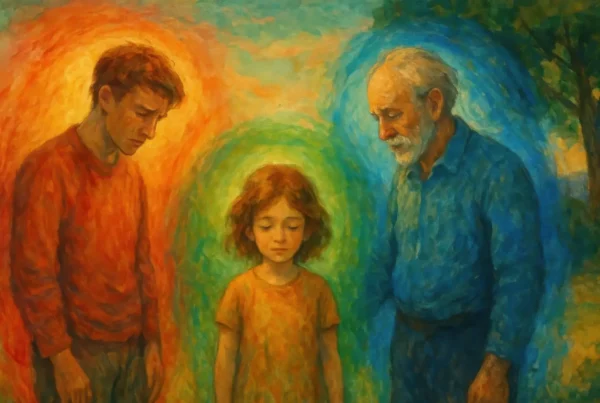BOOK YOUR WORKSHOP TODAY
All posts published here are presented as casual conversation pieces to provoke thought in some direction or another, they do not necessarily represent fixed opinions of the Inner Council, as our work exists beyond the spectrum of bound statement and singular clause.
A guide to understanding trauma as invisible energy, exploring how fragmentation transforms into coherence through safety, compassion and relational healing.
Key Takeaways
- Trauma acts like invisible radiation, disrupting inner balance and coherence.
- The real harm comes from the lingering “fallout” the psyche carries afterward.
- Defenses form as shielding, protecting us but also blocking warmth and connection.
- Healing happens when fragmented energy is safely contained and reorganized.
- Co-regulation and compassion act like radioprotective fields for the nervous system.
- Traumatic charge transforms into inner light when the self returns to coherence.
Trauma as Ionizing Radiation
There are forms of energy that cannot be seen, only felt by what they leave behind. Radiation is one of them, invisible waves moving through space, altering the structure of what they touch. It has no color, no scent, no warning. Yet once it passes through matter, atoms lose their balance. Bonds break. Molecules begin to behave differently. Life reorganizes around the damage, carrying the signature of that invisible event.
Trauma functions in much the same way.
It moves through the psyche like ionizing radiation, unseen, formless, yet profoundly altering. It strips us of something subtle: safety, coherence, innocence, connection. In an instant, the self becomes charged, fragmented, reactive. What was once a stable inner orbit, feelings, thoughts, instincts moving in rhythm, becomes a field of scattered particles, each seeking a new equilibrium.
The danger is not only in the initial exposure, but in the residual energy it leaves behind. Trauma lingers as a low hum in the body, a quiet radiation of unfinished experience. It affects how we think, bond, love, defend. The psyche adapts, shielding itself behind lead walls of numbness, avoidance, or control. These defenses, like protective suits, preserve life in the short term, but they also prevent light and warmth from getting in.
Healing begins when the system finds ways to reclaim its electrons, when the scattered pieces start to return to orbit, drawn back into coherence through safety, compassion, and truth. Just as in physics, what protects the living organism is not denial of energy, but the skillful containment and transformation of it. The right environment, grounded, attuned, relational, acts as a radioprotective field, allowing the self to metabolize what was once too much to bear. We cannot see trauma the way we see a wound, but we can trace its half-life through generations, through the behaviors, silences, and fears that echo down family lines. To heal it is to change the way energy moves through us: from fragmentation toward integration, from radiation toward light.
The Nature of Radiation
Radiation is simply energy in motion, a transmission through space. Sometimes that energy sustains life: sunlight, warmth, the gentle hum of the electromagnetic field that carries sound and color. But when energy becomes too intense, it crosses a threshold. It becomes ionizing, strong enough to knock electrons from atoms, altering the very structure of matter itself. Ionizing radiation is not inherently evil. It is power in its most concentrated form. It can sterilize, destroy, or illuminate. It can heal a body through medical precision or devastate a landscape when released without containment. The difference lies in context, dosage, and boundary.
When a molecule loses an electron, it becomes unstable, a charged fragment seeking to rebalance. One dislodged atom can set off a chain reaction of instability, as each seeks to reclaim what was lost. This is how radiation injury spreads, not only through direct impact, but through the rippling effect of disturbance.
The psyche works the same way.
A traumatic event is a surge of emotional energy that exceeds the system’s capacity to contain it. It doesn’t destroy the self; it ionizes it. Something once whole becomes fragmented, electrically charged, emotionally reactive. The event passes, but the imbalance remains, a field of ungrounded energy echoing through thought, memory, and behavior. What we call triggers are the aftershocks of this process, emotional atoms reacting to reminders of what once stripped them bare.
The nervous system, flooded and seeking stability, repeats the pattern. It is not broken; it is trying to complete an interrupted reaction. Trauma, then, is not a flaw in the psyche. It is the residue of too much energy, too quickly, without enough containment. Just as radiation exposure overwhelms cellular structure, trauma overwhelms emotional structure. Both are injuries of scale, of intensity meeting vulnerability, and both require environments that can absorb, buffer, and re-pattern that energy before it becomes chronic damage.
The Psyche as an Energetic Field
The human psyche is not a solid object. It is a living field, a constellation of sensations, memories, instincts, and meanings held together by coherence. When we are grounded and safe, our inner world behaves like a stable atom: thoughts and feelings orbit around a clear nucleus of self. There is rhythm, balance, predictable movement. Then something happens, an impact, a shock, a betrayal, a loss, and that coherence collapses. The energy of the event exceeds the containment of the system. Bonds break. One part of the self flies outward in fear, another freezes in place, another tries to hold everything together. The psyche, once a single field, becomes a cluster of charged fragments, each carrying a piece of the original impact.
These fragments do not disappear. They continue to orbit within us, each vibrating with the frequency of the original event. Some are volatile, easily reactivated by reminders of danger. Others drift into numbness, the deep freeze of energy that could not safely discharge. Together they create the subtle radiation of trauma: a constant low-level hum that shapes perception and behavior even when life seems calm on the surface. Every defense mechanism, every avoidance, perfectionism, or hypervigilance, can be understood as a containment strategy. The system builds walls to prevent further ionization, to keep the unstable energy from spilling into consciousness. These walls save us when we need them. They are the psyche’s version of emergency shielding. But they also trap the energy inside, preventing the very recombination that leads to healing.
Healing begins when we can approach the charged areas without being burned, when safety, compassion, and truth form a new kind of containment. In that environment, the scattered particles of experience begin to recognize one another again. What was once isolated starts to rejoin the orbit of the whole. It is not the past itself that heals, but the reconfiguration of energy, the return of rhythm, connection, and relational gravity. Just as the atom stabilizes when its electrons return, the psyche finds peace when its parts are welcomed home.
Fallout: The Lingering Energy of Trauma
Radiation doesn’t end when the explosion stops. Its energy lingers, invisible, odorless, but potent enough to alter life for years, decades, or generations. The landscape might appear calm, yet every particle hums with the memory of exposure. This is the nature of fallout: the event passes, but its frequency remains.
Trauma leaves the same kind of residue.
The nervous system continues to pulse with unfinished reactions, flashes of fear, sudden numbness, unexplained exhaustion. The body remembers the energy that overwhelmed it and quietly organizes itself around survival. Long after the danger has passed, the psyche still behaves as though the air were radioactive. For some, this takes the form of chronic vigilance, scanning for threat, even in safety. For others, it’s a collapse of vitality, the slow inward curling of a system trying to minimize exposure. These are not pathologies; they are natural adaptations to lingering energy. The psyche does not know the difference between ongoing threat and stored charge.
Over time, unprocessed trauma decays, but unevenly. Its “half-life” can extend through generations, its particles carried in stories, silences, and inherited patterns. A child may grow up breathing the emotional air of a family still marked by an unspoken explosion: war, displacement, loss, betrayal. The energy of what was never expressed becomes ambient, part of the psychic atmosphere.
In collective terms, entire cultures can carry this residue. The fallout of violence, oppression, or disconnection becomes normalized, invisible but omnipresent, shaping institutions and relationships alike. The system adapts by hardening, numbing, or overcompensating. Yet beneath the surface hums the same longing for restoration, for the energy to settle back into coherence. Healing, in this sense, is not a sudden cure but a slow detoxification. It requires environments that can safely contain and metabolize residual energy, just as contaminated soil is rehabilitated over time, layer by layer. The process is one of reoxygenation: letting breath, warmth, and relationship penetrate what has been sealed off.
To heal trauma is to change the half-life of pain. Each act of awareness, compassion, and truth shortens its duration, converting what was once radioactive into something fertile, an energy that can now sustain life instead of distorting it.
Radioprotective Forces
In physics, the danger of radiation is not simply its power, but exposure without protection. Scientists speak of three principles of safety: time, distance, and shielding. Limit the duration of contact, create space between the source and the body, and build barriers strong enough to absorb or deflect the energy.
The same principles apply to the inner world.
In the aftermath of trauma, the psyche instinctively builds shields, walls of numbness, control, dissociation, or hyperactivity. These are not failures; they are acts of protection. They give the inner system time to cool, to survive the initial intensity of the blast. Yet what saves us in crisis can imprison us in recovery. Walls built to contain radiation also block sunlight. Healing begins when we replace hard shields with living ones, boundaries that protect without isolating. These are the psychic equivalents of organic matter that can absorb and recycle energy: safe relationships, grounded presence, and compassionate witnessing. They do not deflect energy; they metabolize it. The nervous system is not healed by avoidance but by co-regulation, contact with a steady field that helps it find its natural rhythm again.
A calm nervous system in another person functions like a radioprotective agent, absorbing excess charge and offering stability until the system recalibrates. This is why genuine safety, emotional, relational, and environmental, is the foundation of all trauma work. In the physical world, scientists discovered that certain compounds, especially plant-based ones, can reduce radiation damage by neutralizing free radicals. These phytonutrients donate stability to unstable molecules without losing their own integrity. The psyche works the same way: compassion, truth, and love act as emotional antioxidants. They give without depletion, stabilizing the field of another through resonance.
Healing, then, is not a solitary process but an ecological one. Just as the earth repairs itself through cycles of regeneration, the human psyche repairs itself within the ecosystem of relationship. Presence, empathy, ritual, and beauty are our emotional nutrients. They turn toxicity into fertility, shock into story, isolation into communion. When these elements are present, the charge of trauma begins to settle. The self no longer needs to shield itself completely. Energy that once fragmented can now flow into expression, understanding, and connection. What was once radioactive becomes radiant.
Epilogue, The Fire at the Center
In every human being there burns a small, steady fire, the original warmth of presence. Trauma may scatter the embers, but it never extinguishes them. When we turn inward with compassion, when we build safe containers around our tenderness, we invite that fire back to the center.
This is the essence of revillaging within: to create, inside and between us, the emotional ecology where lost parts can return home. The Inner Child, once shielded and silent, becomes the guide, the one who knows what safety feels like, who leads the adult self back toward connection.
In this return to coherence, the individual becomes a village again: each part recognized, each emotion given its place around the fire. And the energy that once harmed begins to heal, not by disappearing, but by changing its nature. From radiation to light. From fragmentation to family.
Visit our Inner Child Workshop page to find out more.
Further Reading to Restore Rhythm
- Tara Brach – Radical Acceptance
Presence as the antidote to fragmentation, learning to meet pain with gentleness instead of exile. - Thomas Moore – Care of the Soul
A reminder that healing is not fixing, but tending, love as the quiet radiance that restores coherence. - Stephen Harrod Buhner – The Secret Teachings of Plants
A lyrical exploration of the heart’s electromagnetic intelligence, the living proof that empathy itself is a frequency. - Bill Plotkin – Soulcraft: Crossing into the Mysteries of Nature and Psyche
Explores how initiation and time in nature return us to the soul’s seasonal rhythm. Healing as synchronization with deeper cycles.





